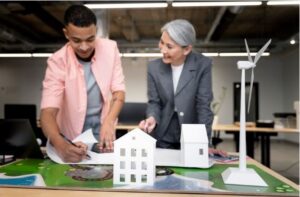In the face of climate change and the growing demand for sustainable living, eco-friendly construction has transitioned from a niche market into a global movement. Among the most promising paradigms in this realm is the concept of Net-Zero energy buildings. These structures are designed to produce as much energy as they consume over a year, offering a sustainable blueprint for the future of construction. If you’re fascinated by the prospects of contributing to this green revolution, it’s essential to understand the foundational elements and innovations driving eco-friendly construction. Below, we explore key areas of study to equip yourself with the knowledge to make meaningful contributions to this burgeoning field.
Understanding the Fundamentals of Sustainable Design
The road to mastering eco-friendly construction begins with a deep dive into sustainable design principles. This encompasses learning about:
- Energy Efficiency: Study the strategies to minimize energy requirements in buildings, including insulation techniques, natural ventilation, and implementing energy-efficient appliances and lighting.
- Renewable Energy Systems: Gain insights into solar panels, wind turbines, and geothermal systems that can power buildings sustainably.
- Materials Science: Delve into the world of sustainable building materials like bamboo, recycled steel, and thermal insulation made from sheep’s wool or recycled denim. Understanding the life cycle assessment (LCA) of materials is critical to evaluate their environmental impact.
- Water Conservation: Learn about rainwater harvesting, greywater systems, and efficient sanitary fixtures that reduce water usage.
Exploring Net-Zero Energy Concepts
A Net-Zero energy building seamlessly integrates design and technology to achieve a balance between energy consumption and generation. Focus your study on:
-
- Net-Zero Building Design: This involves an integrated approach to architecture and engineering, focusing on minimizing energy needs through building orientation, layout, and incorporating passive solar design principles.
- Energy Modeling and Simulation Software: Familiarize yourself with tools like EnergyPlus or SketchUp with Sefaira, which can simulate energy flows in a building to optimize its design for minimal energy consumption and maximum comfort.
- Advanced HVAC and Lighting Systems: Learn about high-efficiency heating, ventilation, and air conditioning (HVAC) systems, as well as smart lighting solutions that adapt to occupancy and natural light levels to minimize energy use.
- Energy Storage Solutions: Study battery storage technologies and thermal mass materials that can store excess energy for use during peak demand times or unfavorable conditions for energy generation. Learn more from net zero energy buildings course.

Integrating Smart Technology and IoT
In the quest for Net-Zero energy, the role of smart technology and the Internet of Things (IoT) cannot be overstated. These technologies help monitor and control energy use in real time. Areas to focus on include:
- Smart Home Systems: Explore systems that integrate HVAC, lighting, and electrical appliances, allowing for automated or remote control to optimize energy usage.
- IoT Sensors and Analytics: Study how sensors can collect data on environmental conditions, occupancy, and energy consumption and how analytics can turn this data into actionable insights for further energy savings.
Prioritizing Health and Well-being
Eco-friendly construction also emphasizes creating environments that support the occupants’ health and well-being. Study areas related to:
- Indoor Environmental Quality (IEQ): Learn about strategies to improve air quality, natural lighting, and acoustic comfort within buildings.
- Biophilic Design: This design philosophy seeks to connect building occupants more closely to nature, incorporating natural lighting, ventilation, and green spaces.
Engaging with Policy and Building Codes
Understanding the legal landscape, including zoning laws, building codes, and incentives for green construction, is crucial. Study how policy can influence sustainable building practices and how to design within these frameworks to promote eco-friendly construction.
Embarking on Your Educational Journey
To immerse yourself in these study areas, consider academic programs in sustainable design, environmental engineering, or green architecture. Online courses, workshops, and certifications in specific technologies or principles of sustainable construction complement formal education. Engage with professional organizations, attend conferences, and seek out internships or projects in the field to gain practical experience.

Conclusion
Building a future where construction aligns harmoniously with nature’s principles requires a generation of informed, passionate individuals ready to innovate and advocate for sustainable practices. By equipping yourself with knowledge in these key areas, you can contribute to the evolution of construction towards a greener, more sustainable future. Whether you’re an aspiring architect, an engineer, or simply a green enthusiast, the path to eco-friendly construction and achieving Net-Zero energy buildings is both a noble and necessary pursuit in our collective effort to mitigate climate change.
